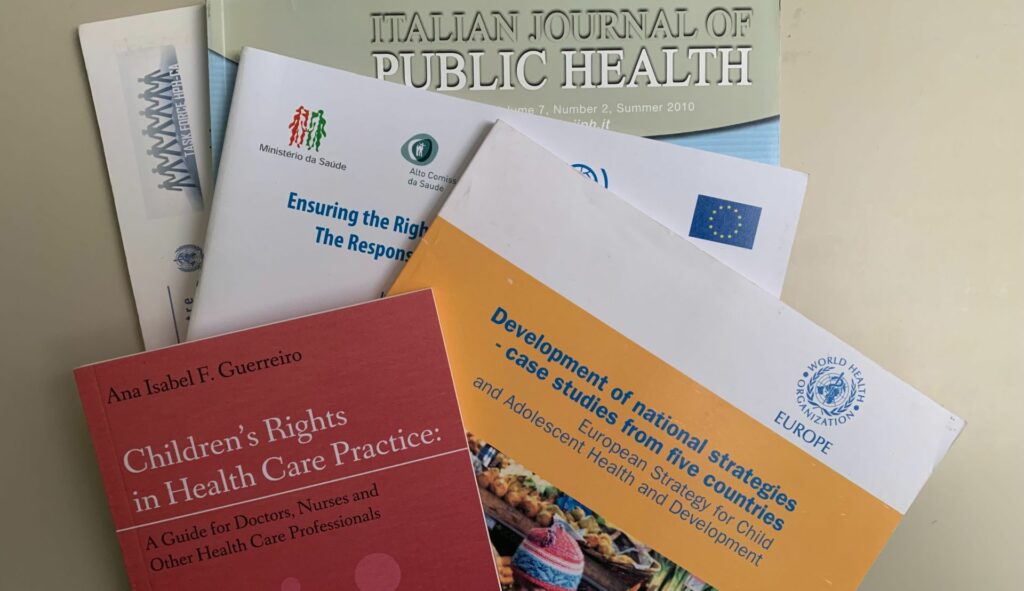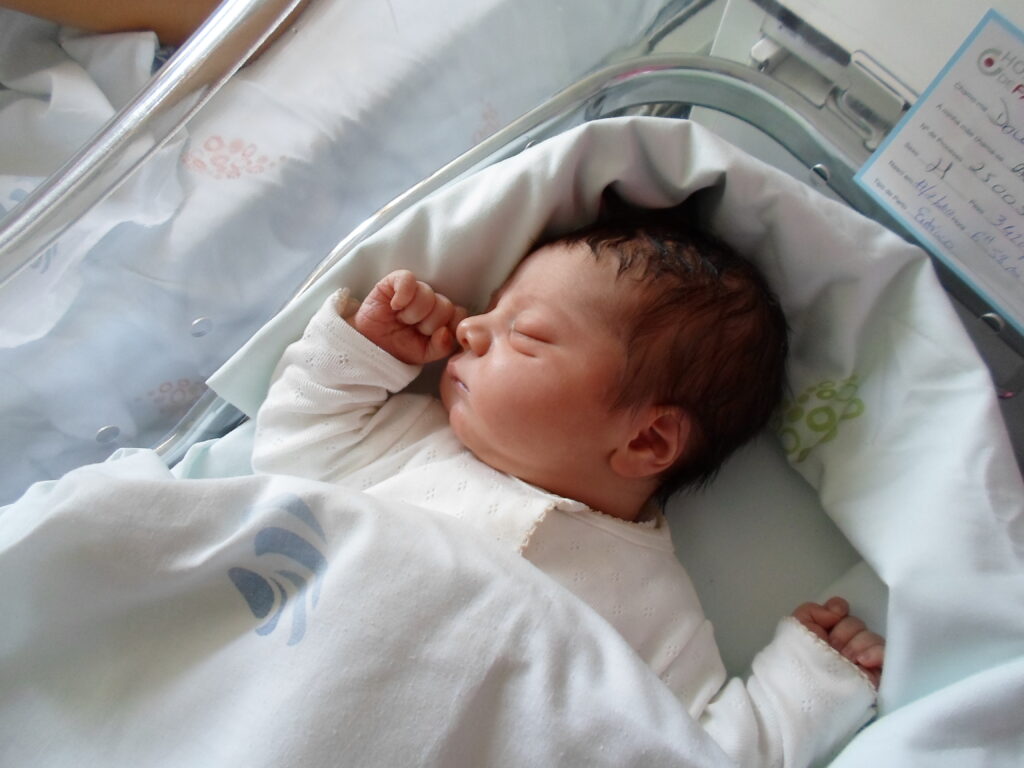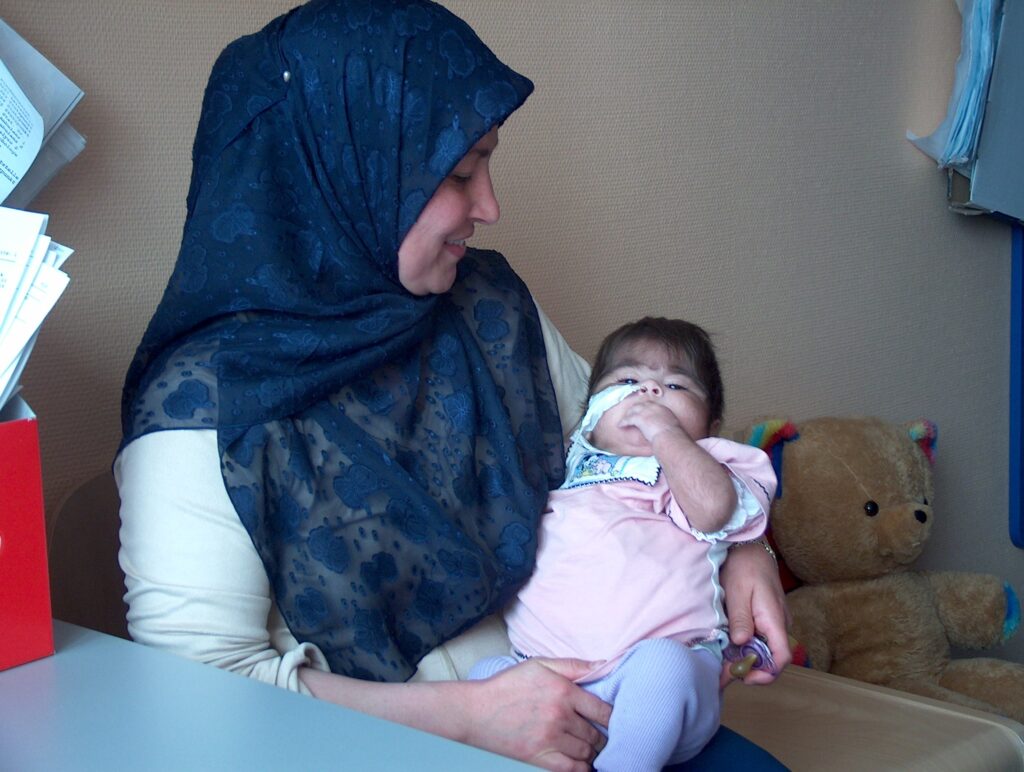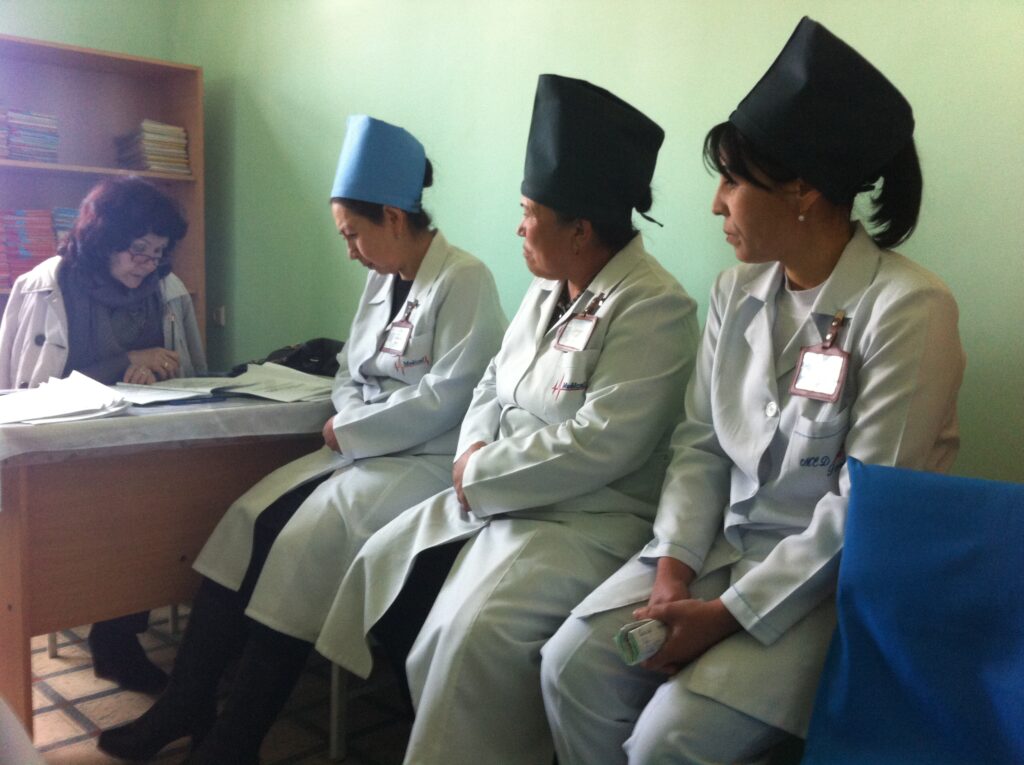Planning: Using the Convention on the Rights of the Child as a framework to improve quality of care
It can be said that it has been a long road to recognise human rights as an essential component of quality improvement processes but, while we have the guidance and knowledge on how to use human and child rights to improve quality of care, these are not yet imbedded in related processes anywhere in the world. Therefore, it is fundamental to continue to raise awareness on the importance of realising children’s rights across all settings, including health care.
A little history: the United Nations Human Rights-based Approach to Planning
In 2003, the United Nations adopted the Human Rights Based Approach to Development Cooperation: Towards a Common Understanding Among UN Agencies, a methodological approach to planning that is based on human rights principles. The table below provides an excerpt of the main messages put forward by the document.
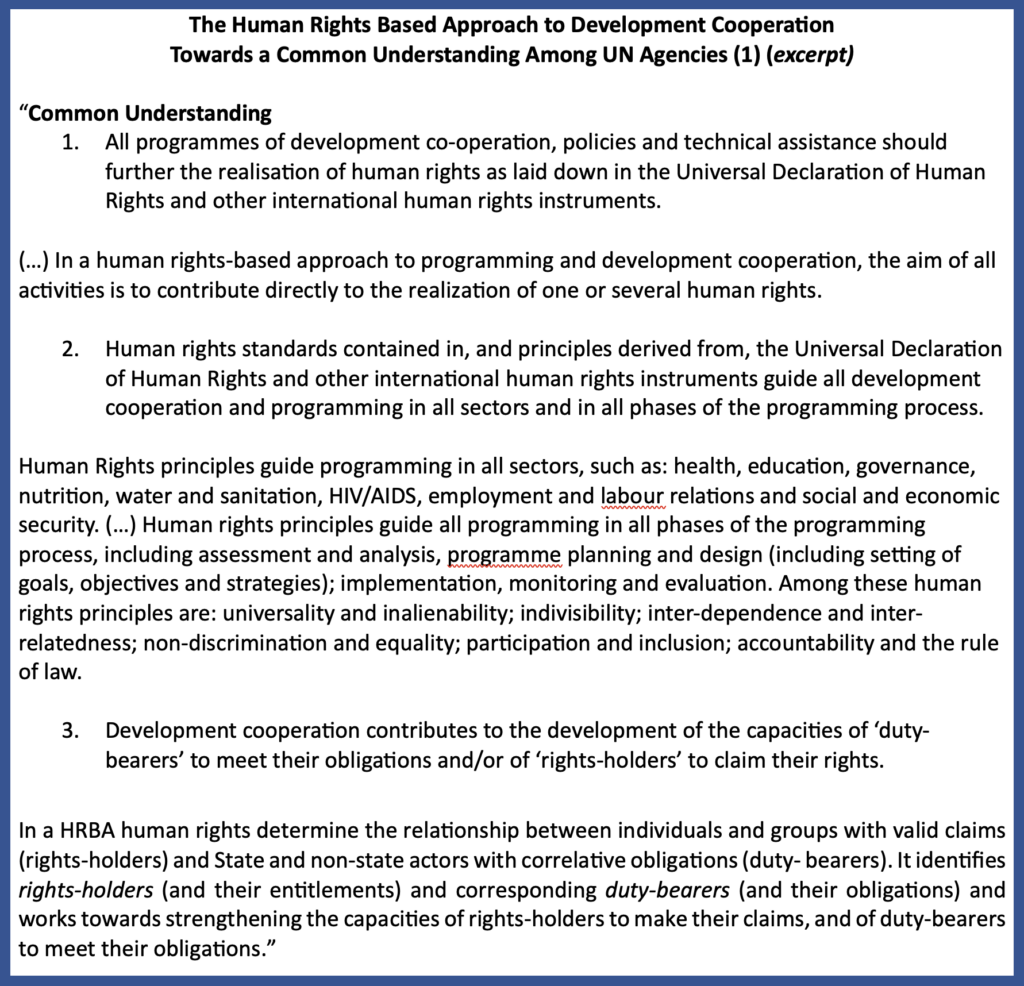
From 2003, the UN agencies, such as WHO and UNICEF, started to use the HRBA to inform their work. In 2013, WHO published the document Women’s and children’s health: evidence of impact of human rights (2) putting forward the key principles of a HRBA adopted to the health care setting and showing evidence of efforts collected around the world. According to WHO:
“(A human rights-based approach to health) aims to realize the right to the highest attainable standard of health (or ”right to health”) and other health-related rights. It underscores that the right to health includes timely and appropriate health care, as well as the underlying determinants of health, such as safe and potable water, sanitation, health-related information and education, and gender equality. It also emphasizes that health-related services and facilities have to be available, accessible, acceptable and of good quality, and that human rights standards and principles, such as participation, equality, non-discrimination and accountability, should guide programming in all health-related sectors and at all stages of the process. A human rights-based approach is not only about the achievement of certain goals or outcomes; it is about their achievement through a participatory, inclusive, transparent and responsive process (2).”
As described in the quote above, the HRBA to health is a comprehensive planning approach that must take into account the comprehensive health situation, including the social determinants affecting a population’s health outcomes; the responsibility of the health care system to ensure that there are enough health care services (principle of availability), organised in a way that is distributed equally throughout a country, including specific actions that guarantee that all people enjoy the same type of care, even if they live in remote areas (principles of accessibility and equality); that the population is aware of the existing services available to them (principle of information) and that they are able to afford them (principle of affordability). Importantly, this is a process that calls for the transparent responsibility of the system and all the stakeholders involved (principle of accountability). This means that there should be effective planning and capacity building to ensure that all professionals working in the health care system, including the health professionals working directly with people have the necessary skills. Finally, it is important to mention one very important human rights principle that is often overlooked: the principle of participation. All people, whether adults or children have the right to participate in all matters that affect their lives. This means that children also have the right to express their opinion and participate in processes for the development, assessment and improvement of health care services (3).
Other useful and important documents have been published that demonstrate how the HRBA to health can be applied in the context of child health and to address specific child health issues. See for example the 2014 Technical guidance on the application of a human rights-based approach to the implementation of policies and programmes to reduce and eliminate preventable mortality and morbidity of children under 5 years of age (Report of the Office of the United Nations High Commissioner for Human Rights).
Why do we need to assess children’s rights in health services
When we talk about improving child health care, we must inevitably discuss how to plan a child health care service. In order to ensure that health care is effectively delivered and planned, it is fundamental to know the situation and to identify gaps for improvement by assessing the situation, to address those gaps by promoting actions that will contribute to change, and to monitor and evaluate change, to ensure that our intervention is having the expected effects. In other words, we must apply a quality improvement cycle, as illustrated below:
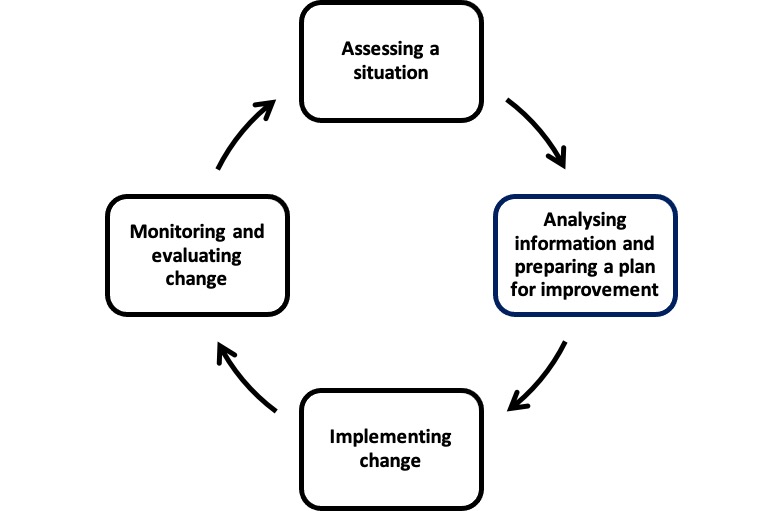
How do we use the Convention on the Rights of the Child as a basis to improve quality of care
Child rights principles should be integrated at all levels of the health care system, particularly in the planning processes. In its Regional Framework for Improving the Quality of Care for Reproductive, Maternal, Neonatal, Child and Adolescent Health in the WHO European Region, WHO recommends that quality health care services for children should be improved by:
- “Integrating human rights provisions in quality improvement processes;
- Identifying key areas for improvement;
- Addressing bottlenecks that hinder the provision and continuum of care within health services and beyond;
- Implementing a continuous and sustainable quality improvement system;
- Enhancing the implementation of human rights provisions and improving monitoring and reporting to UN Human Rights Treaty Bodies (such as the Committee on the Rights of the Child).”
All stakeholders and institutions at national, regional and local level have an important role to play in this process. Due to the complexity of child health and the various components that must be in place to ensure quality of care, a comprehensive and collaborative quality improvement system should be put in place. Following an assessment of child rights carried out by WHO in the Republic of Moldova, Kyrgyzstan and Tajikistan, myself and colleagues in the WHO Regional Office for Europe suggested the process illustrated below.
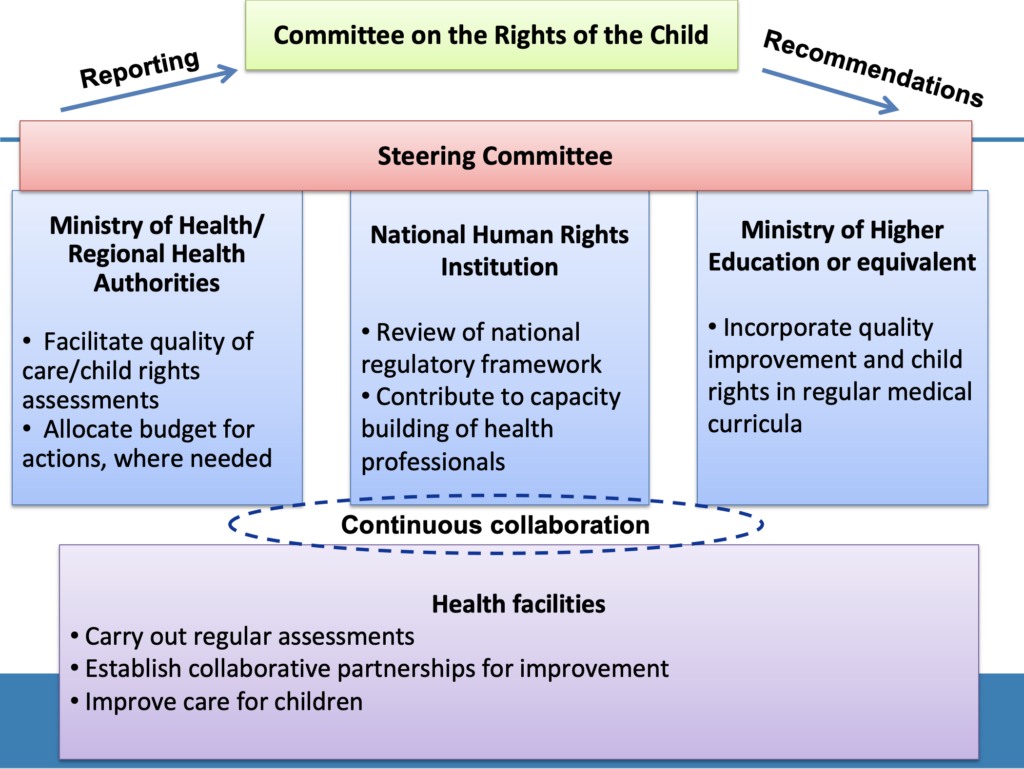
In the publication Assessing and Improving Children’s Rights in Hospitals: Case Studies from Kyrgyzstan, Tajikistan, and Moldova, we have recommended a process that we believe would be necessary to bring about systemic and long-term change, in line with child rights. This includes setting up a national steering committee made up of key institutions, i.e. Ministry of Health, national human rights institutions, civil society organisations and other governmental entities, whose mandate may have an impact on child health; tasked to review the national regulatory framework (including health-related legislation, policies and programmes), taking into account the HRBA to health; and to put in place a continuous quality improvement process at the level of health care services, to ensure quality of care for all children.
Secondly, we recommended the collaboration between the Ministry of Health and the Ministry of Higher Education or equivalent to progressively integrate child rights and quality of care in medical curricula. Ministries of health should also make budgets available to the extent of their resources, in line with CRC provisions, specifically article 4, to promote improvements. We further recommended that the international research community to undertake a randomized control trial of the use of the assessment tools and to measure its impact on quality of care and child health outcomes.
We believe this process should be linked to and would enhance the periodic reporting to the Committee on the Rights of the Child, in the context of Article 24 on children’s right to the highest attainable standard of health, as provided in General Comment No 15 of the Committee.
(1) United Nations Development Group (2003) The Human Rights Based Approach to Development Cooperation Towards a Common Understanding Among UN Agencies
(2) Women’s and children’s health: evidence of impact of human rights / Flavia Bustreo, Paul Hunt … [et al]. World Health Organization 2013
(3) Committee on the Rights of the Child (2009) General Comment N. 12 on the right of the child to be heard


